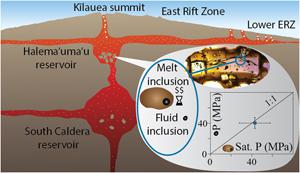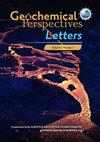将富含二氧化碳的流体包裹体的拉曼分析作为基劳埃阿的大地晴雨表的可靠性
IF 3.7
1区 地球科学
Q1 GEOCHEMISTRY & GEOPHYSICS
引用次数: 0
摘要
解读火山动荡的信号需要了解岩浆系统的结构,特别是岩浆储存的深度。这些信息对于帮助预测喷发方式和强度的变化至关重要。然而,用于评估岩浆储存深度的常用岩石学工具(如熔融包裹体)成本高昂、不确定性大,而且速度太慢,无法进行实时监测。在此,我们评估了拉曼光谱测量以二氧化碳为主的流体包裹体作为地质气压计的可靠性,以及微测温和熔融包裹体气压计的可靠性。我们计算了2018年Kīlauea东裂谷带下段喷发的102个橄榄石寄存流体包裹体的储存压力,这些压力在统计上与熔融包裹体测定的压力没有区别。我们的研究表明,对于以二氧化碳为主的流体包裹体(<10 mol % H2O),校准拉曼光谱法得出的密度在微测温法的5-10%范围内,但对于像Kīlauea这样以浅层岩浆贮存为主的系统,这种方法要合适得多。总之,通过拉曼光谱测定流体包裹体的压力是可靠的,所需的时间和资源只是熔融包裹体研究的一小部分。本文章由计算机程序翻译,如有差异,请以英文原文为准。

Reliability of Raman analyses of CO2-rich fluid inclusions as a geobarometer at Kīlauea
Interpreting signals of volcanic unrest requires knowledge of the architecture of the magmatic system, particularly the depths at which magmas are stored. Such information can be vital to help predict changes in eruptive style and vigour. However, popular petrological tools to assess magma storage depths (e.g., melt inclusions) are costly, present large uncertainties, and are too slow for real time monitoring. Here, we evaluate the reliability of Raman Spectroscopy measurements of CO2-dominated fluid inclusions as a geobarometer relative to microthermometry and melt inclusion barometry. We calculate storage pressures for 102 olivine-hosted fluid inclusions from the 2018 Lower East Rift Zone eruption of Kīlauea, which are statistically indistinguishable to those determined from melt inclusions. We show that calibrated Raman spectroscopy yields densities within 5–10 % of microthermometry for CO2-dominated fluid inclusions (<10 mol % H2O) but is a far more suitable method for systems like Kīlauea dominated by shallow magma storage. Overall, pressures determined from fluid inclusions by Raman spectroscopy are robust and require only a fraction of the time and resources of melt inclusion studies.
求助全文
通过发布文献求助,成功后即可免费获取论文全文。
去求助
来源期刊

Geochemical Perspectives Letters
Earth and Planetary Sciences-Geochemistry and Petrology
CiteScore
7.00
自引率
2.00%
发文量
42
审稿时长
15 weeks
期刊介绍:
Geochemical Perspectives Letters is an open access, internationally peer-reviewed journal of the European Association of Geochemistry (EAG) that publishes short, highest-quality articles spanning geochemical sciences. The journal aims at rapid publication of the most novel research in geochemistry with a focus on outstanding quality, international importance, originality, and stimulating new developments across the vast array of geochemical disciplines.
 求助内容:
求助内容: 应助结果提醒方式:
应助结果提醒方式:


